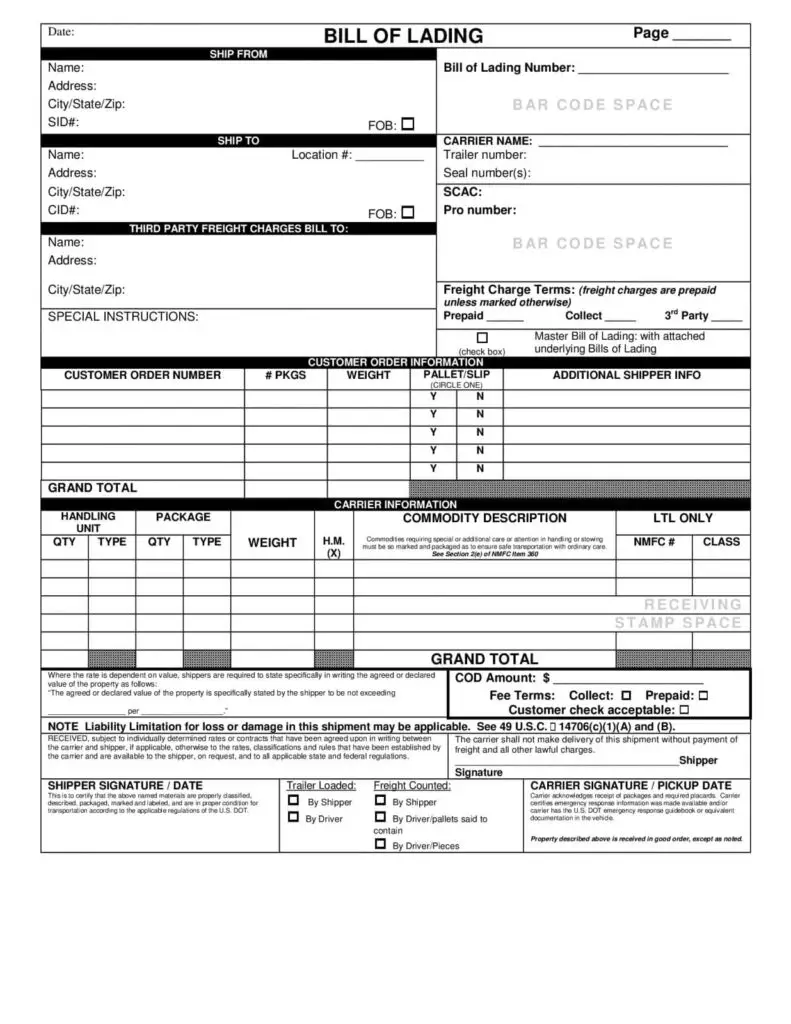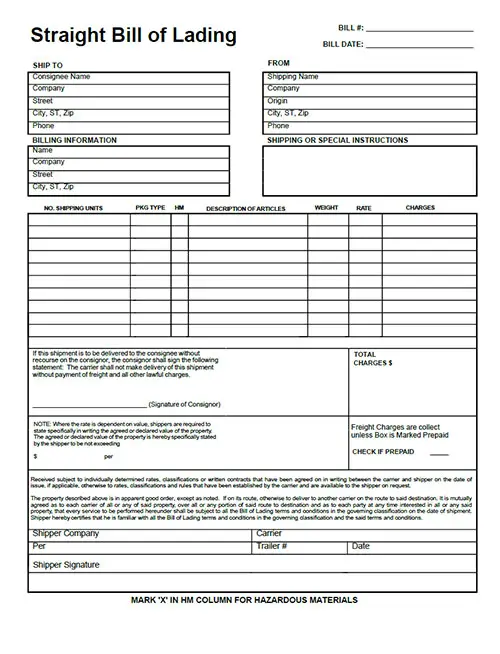What Is A Bill Of Lading (BoL)?
A Bill of Lading is a document issued by a Carrier (somebody who transports and delivers goods) to a Shipper (someone who supplies and/or owns the goods – also known as a Consignor), confirming goods were received in an acceptable condition and are ready to be shipped. Those goods will then be delivered by the carrier to a Consignee (the person who bought the goods in the first place). A Bill of Lading is essentially a contract of carriage between the Shipper, Consignee, and Carrier stating the terms and conditions of carriage.

What Is In a Bill of Lading?
Typically, a bill of lading will include the names and addresses of the shipper (consigner) and receiver (consignee), shipment date, quantity, exact weight, value, and freight classification. Additionally, a complete description of the items including whether they’re classified as hazardous, type of packaging used, any specific instructions for the carrier, and any special order tracking numbers are included.
What To Include In a Bill of Lading
The BOL should include specific information such as:
- The number of units to be shipped.
- The precise weight of the shipment (multiple freight units call for each item’s weight to be listed).
- Shipper and receiver names and addresses.
- The date of shipment.
- The carrier’s unique instructions.
- The kind of packaging (ex: pallets, drums, skids, cartons).
- The stated value of the cargo being shipped.
- A complete description of the item being shipped, with specifics about the common name and the material used to manufacture it.
- The freight classification.
- Account number or PO used for order tracking between companies.
- A note explaining whether the freight is a DoT hazardous material. (If so, there are specific rules and regulations about shipping such materials.)
KEY TAKEAWAYS
- A bill of lading is a legal document issued by a carrier to a shipper that details the type, quantity, and destination of the goods being carried.
- A bill of lading is a document of title, a receipt for shipped goods, and a contract between a carrier and shipper.
- This document must accompany the shipped goods and must be signed by an authorized representative from the carrier, shipper, and receiver.
- If managed and reviewed properly, a bill of lading can help prevent asset theft.
The Importance of Bills of Lading
The carrier need not require all originals to be submitted before delivery. It is therefore essential that the exporter retains control over the full set of the originals until payment is effected or a bill of exchange is accepted or some other assurance for payment has been made to him.
A bill of lading, therefore, is a very important issue when making shipments to move the cargo or freight from one point to the other. On one hand, it is a contract between a carrier and shipper for the transportation of goods and on the other hand, it serves as a receipt issued by a carrier to the shipper.
Hence, the bill of lading is considered a legal document which provides all the vital details to the shipper and the carrier to conveniently process the freight shipment through different maritime countries and invoice it correctly.
The original copy of the bill of lading is provided to the carrier, and a copy of the same should also be ascribed to the packaged freight.
Different Types Of Bills Of Lading
There are many different types of Bills of Lading. They differ based on many factors such as the:
- Issuer of the BoL,
- The purpose of the BoL,
- Its form of transmission,
- The relationship between buyer and seller,
- The protection it offers to the buyer.
The main types of bill of lading dealt with for international transport are Ocean Bill of Lading, Seaway Bill of Lading, House Bill of Lading, Master Air Way Bill of Lading, House Air Way Bill of Lading and occasionally Switch Bill of Lading. We will cover each one of them below. But first, there are two main categories that bills of ladings fall in that you need to know: negotiable and non-negotiable.
Negotiable and Non-negotiable bill of lading?
Negotiable bill of lading: In this type of bill, clear instruction is provided to make the delivery of the goods to anyone having the possession of the original copy of the bill, which itself signifies the title and control of the freight. In this type of bill, the buyer/ receiver or his/her agent has to acquire and present an original copy of the bill of lading at the discharge port. In the absence of original bill copy, the freight will not be released.
Non-negotiable bill: This type of bill of lading fixes a specific consignee/name of the receiver to whom the freights will be shipped and delivered. It, however, does not itself serve the ownership of the goods. Under this type of bill, the assigned receiver/ buyers can claim the cargo by confirming their identity.
Check out our instruction to how to write a Commercial invoice and Pro-Forma invoice for more details.







